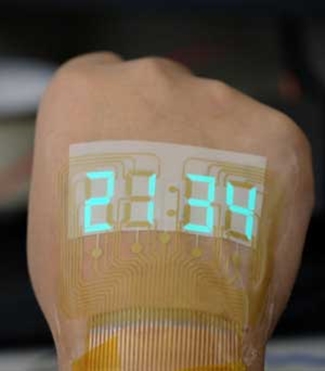|
NOVIDADES
Imagine a runner who doesn’t need to carry a stopwatch or cell phone to check her time: She could just gaze at the glowing stopwatch display on the back of her hand. Such human-machine interfaces are no longer science fiction, but they still have a way to go before becoming mainstream. Now, researchers reporting in ACS Materials Letters ("Stretchable High-Permittivity Nanocomposites for Epidermal Alternating-Current Electroluminescent Displays") have developed a stretchable light-emitting device that operates at low voltages and is safe for human skin.  A stretchable light-emitting device becomes an epidermal stopwatch. Credit: ACS
However, the displays require relatively high voltages to achieve sufficient brightness, which could create safety concerns. So, Desheng Kong and colleagues wanted to develop an ACEL that could operate at lower voltages and thus be safer for human skin. To make their device, the researchers sandwiched an electroluminescent layer, made of light-emitting microparticles dispersed in a stretchable dielectric material, between two flexible silver nanowire electrodes. The device contained a new type of dielectric material, in the form of ceramic nanoparticles embedded in a rubbery polymer, that increased the brightness compared with existing ACEL displays. They used this material to make a four-digit stopwatch display, which they mounted onto a volunteer’s hand. At low voltages, the stretchable display was sufficiently bright to be seen under indoor lighting. The bright stretchable display could find a broad range of applications in smart wearables, soft robotics and human-machine interfaces, the researchers say. American Chemical Society. Accessed: Nov 04, 2019. |
|||||||||||||||||||||||||